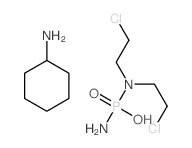Phosphoramide mustard (cyclohexanamine)
Modify Date: 2024-01-17 10:11:02

Phosphoramide mustard (cyclohexanamine) structure
|
Common Name | Phosphoramide mustard (cyclohexanamine) | ||
|---|---|---|---|---|
| CAS Number | 1566-15-0 | Molecular Weight | 320.19600 | |
| Density | N/A | Boiling Point | 363.5ºC at 760mmHg | |
| Molecular Formula | C10H24Cl2N3O2P | Melting Point | 100-103 °C | |
| MSDS | N/A | Flash Point | 173.6ºC | |
Use of Phosphoramide mustard (cyclohexanamine)Phosphoramide mustard cyclohexanamine is the major metabolite for Cyclophosphamide (HY-17420), with anticancer activitiy. Phosphoramide mustard cyclohexanamine induces DNA adduct formation in ovarian granulosa cells, induces DNA damage and elicits the ovarian DNA repair response[1][2]. |
| Name | amino-[bis(2-chloroethyl)amino]phosphinic acid,cyclohexanamine |
|---|---|
| Synonym | More Synonyms |
| Description | Phosphoramide mustard cyclohexanamine is the major metabolite for Cyclophosphamide (HY-17420), with anticancer activitiy. Phosphoramide mustard cyclohexanamine induces DNA adduct formation in ovarian granulosa cells, induces DNA damage and elicits the ovarian DNA repair response[1][2]. |
|---|---|
| Related Catalog | |
| In Vitro | Phosphoramide mustard cyclohexanamine causes cytotoxicity through forming cross-linked DNA adducts which inhibit DNA strand separation during replication[1]. Phosphoramide mustard cyclohexanamine destroys rapidly dividing cells by forming NOR-G-OH, NOR-G and G-NOR-G adducts with DNA, potentially leading to DNA damage[1]. Phosphoramide mustard cyclohexanamine (3-6 μM; 48 hours) reduces cell viability in rat spontaneously immortalized granulosa cells (SIGCs)[1]. Phosphoramide mustard cyclohexanamine (3-6 μM; 24-48 hours) induces DNA adduct formation[1]. Phosphoramide mustard cyclohexanamine (3-6 μM; 24-48 hours) induces ovarian DNA damage in rat ovaries[1]. Phosphoramide mustard cyclohexanamine increases DNA damage responses (DDR) gene (Atm, Parp1, Prkdc, Xrcc6, Brca1, Rad51) mRNA expression level[1]. Phosphoramide mustard cyclohexanamine (3-6 μM; 24-48 hours) increased DDR proteins[1]. Cell Viability Assay[1] Cell Line: SIGCs Concentration: 0.5 μM, 1 μM, 3 μM, 6 μM Incubation Time: 48 hours Result: Reduced cell viability at concentrations of 3 μM and higher. RT-PCR[1] Cell Line: SIGCs Concentration: 3 μM, 6 μM Incubation Time: 24 hours, 48 hours Result: Increased DDR gene mRNA expression levels. Western Blot Analysis[1] Cell Line: SIGCs Concentration: 3 μM, 6 μM Incubation Time: 24 hours, 48 hours Result: Generally increased DDR proteins. |
| In Vivo | Phosphoramide mustard cyclohexanamine (2.1-20.7 mg/kg; i.p.; daily; for 5 days) inhibits subcutaneous tumor growth in rats[2]. Phosphoramide mustard cyclohexanamine (86.0 mg/kg; i.v.) has a plasma disappearance half-life of 15.1 minutes[2]. Animal Model: Rat, subcutaneously implanted Walker 256 carcinosarcoma tumor[2] Dosage: 2.1 mg/kg, 4.8 mg/kg, 10.4 mg/kg, 20.7 mg/kg Administration: Intraperitoneal injection, once daily, for 5 consecutive days Result: Required to produce 50% inhibition of subcutaneous tumor growth with dose of 12 mg/kg. Animal Model: Rats[2] Dosage: 86.0 mg/kg (Pharmacokinetic Analysis) Administration: Intravenous injection Result: Had a disappearance half-life of 15.1 minutes in plasma. |
| References |
| Boiling Point | 363.5ºC at 760mmHg |
|---|---|
| Melting Point | 100-103 °C |
| Molecular Formula | C10H24Cl2N3O2P |
| Molecular Weight | 320.19600 |
| Flash Point | 173.6ºC |
| Exact Mass | 319.09800 |
| PSA | 102.39000 |
| LogP | 3.50350 |
| Vapour Pressure | 2.84E-06mmHg at 25°C |
| InChIKey | BGTIPRUDEMNRIP-UHFFFAOYSA-N |
| SMILES | NC1CCCCC1.NP(=O)(O)N(CCCl)CCCl |
| n,n-bis(2-chloroethyl)phosphorodiamidic acid-cyclohexanamine(1:1) |
| Phosphorodiamidic acid,N,N-bis(2-chloroethyl)-,cyclohexylamine salt |
| phosphoramide mustard cyclohexylammonium salt |
| Cyclohexylammonium Hydrogen N,N-di-(2-chloroethyl)phosphorodiamidate |
| Phosphoramide mustard cyclohexamine salt |
| phosphoramide mustard cyclohexylamine salt |
| Phosphorodiamidic acid,N,N-bis(2-chloroethyl)-,compd. with cyclohexanamine (1:1) |
| OMF 59 |
| cyclohexylamine,salt of/the/ N,N-bis-(2-chloro-ethyl)-diamidophosphoric acid |
| Cyclohexylamin,Salz der N,N-Bis-(2-chlor-aethyl)-diamidophosphorsaeure |
| N,N-bis(2-chloroethyl)phosphorodiamidic acid cyclohexylammonium salt |